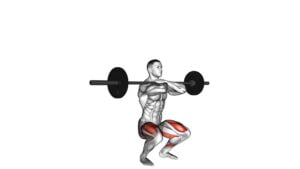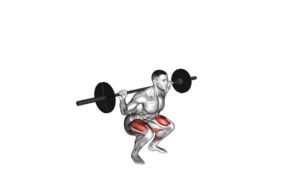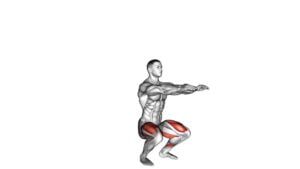Dumbbell Pause Squat (female) – Video Exercise Guide & Tips

Looking to strengthen your lower body? The dumbbell pause squat is a great exercise for females.
Watch This Exercise Video
This video exercise guide and tips will show you the proper form and technique. You'll also learn modifications for beginners and how to maximize the effectiveness of the exercise.
Avoid common mistakes and get the most out of your workout. Get ready to feel the burn and see results with the dumbbell pause squat.
Key Takeaways
- Dumbbell Pause Squat targets quads, glutes, and hamstrings, helping to tone and sculpt the lower body.
- Engaging core and improving balance and stability are additional benefits of this exercise.
- Gradually increasing weights for progression is recommended to challenge the muscles.
- Dumbbell Pause Squat is a suitable strength training exercise for women to incorporate into their fitness routine.
Benefits of Dumbbell Pause Squat for Females
To reap the benefits of the dumbbell pause squat as a female, focus on building strength and toning your lower body. The dumbbell pause squat is an effective exercise that targets your quads, glutes, and hamstrings, giving you a toned and sculpted lower body. By incorporating dumbbell pause squat variations into your workout routine, you can add variety and challenge to your training.
One of the best dumbbell squat workouts for women is the goblet pause squat. Hold a dumbbell vertically in front of your chest, with your elbows pointing down. As you squat down, pause for a moment at the bottom, then push through your heels to stand back up. This exercise engages your core and helps improve your balance and stability.
Another variation to try is the Bulgarian split squat with dumbbells. Stand with one foot forward and the other foot resting on a bench or step behind you. Hold a dumbbell in each hand and lower your back knee towards the ground, keeping your front knee aligned with your ankle. Pause at the bottom, then push through your front heel to stand back up.
Incorporating these dumbbell pause squat variations into your workout routine won't only help you build strength and tone your lower body, but also improve your balance and stability. Remember to start with lighter weights and gradually increase as you get stronger.
Equipment Needed for Dumbbell Pause Squat
To perform the dumbbell pause squat, you'll need some essential equipment.
First, you'll need a pair of dumbbells that are suitable for your strength level. These will provide the resistance needed to challenge your muscles during the exercise.
Additionally, you may want to consider using a weightlifting belt for added support and stability.
Essential Equipment for Squats
To perform the Dumbbell Pause Squat exercise, you'll need essential equipment. Here are the recommended items for squat exercises:
- Dumbbells: These will provide the resistance needed to challenge your muscles and increase strength.
- Squat rack: This equipment will help you maintain proper form and ensure safety during the exercise.
- Weightlifting belt: It can provide additional support to your core and lower back, reducing the risk of injury.
- Flat-soled shoes: Opt for shoes with good stability and a flat sole to provide a solid base for your feet.
- Knee sleeves: These can offer extra support and compression to your knees, reducing the risk of strain or injury.
Now that you know the essential gear for squatting, let's move on to the benefits of dumbbell squats.
Benefits of Dumbbell Squats
Equip yourself with the necessary gear for dumbbell squats to reap the benefits of this exercise.
Dumbbell squats are a fantastic way for women to incorporate strength training into their fitness routine. By adding dumbbells to your squats, you increase the resistance and challenge your muscles even more. This can lead to increased muscle strength and tone in your lower body, including your quadriceps, hamstrings, and glutes.
Additionally, dumbbell squats allow for a variety of variations, such as goblet squats or sumo squats, which target different muscle groups and add variety to your workouts.
Strength training is especially beneficial for women, as it helps to increase bone density, improve posture, and boost metabolism.
Alternatives to Dumbbells
If you don't have access to dumbbells, there are alternative equipment options for the dumbbell pause squat exercise. Here are some dumbbell alternatives and variations of pause squats that you can try:
- Barbell Pause Squat: Use a barbell instead of dumbbells to perform the pause squat. It provides a similar challenge and targets the same muscles.
- Kettlebell Goblet Pause Squat: Hold a kettlebell in front of your chest and perform the pause squat. This variation engages your core and upper body more.
- Bodyweight Pause Squat: If you don't have any equipment, you can still do pause squats using just your bodyweight. Focus on maintaining proper form and engaging your muscles.
- Resistance Band Pause Squat: Attach a resistance band around your thighs and perform the pause squat. The band adds extra resistance and challenges your muscles.
- Weighted Backpack Pause Squat: Fill a backpack with books or other heavy objects and wear it while doing the pause squat. This makeshift weight provides resistance for your workout.
Remember to always consult with a professional before trying new exercises or using alternative equipment.
Proper Form and Technique for Dumbbell Pause Squat
Start by holding a pair of dumbbells at your sides.
To perform the dumbbell pause squat with proper form and technique, it's essential to avoid common mistakes and make modifications for beginners.
One common mistake isn't maintaining proper alignment. Ensure that your feet are hip-width apart and toes slightly turned out. Keep your chest lifted, shoulders back, and core engaged throughout the exercise.
Another mistake to avoid is going too deep into the squat, which can strain your knees and lower back. Aim to lower your hips until your thighs are parallel to the ground and then pause for a brief moment before ascending back up. This pause helps activate your muscles and ensures proper control and stability.
For beginners, it's recommended to start with lighter dumbbells or no weights at all until you have mastered the correct form. Gradually increase the weight as you gain strength and confidence.
Modifications for Beginners in Dumbbell Pause Squat
To make modifications for beginners in the dumbbell pause squat, it's important to focus on building strength and maintaining proper form. Here are some beginner modifications to help you get started:
- Start with bodyweight squats: Begin by mastering the basic squat movement without any additional weight. This will help you develop proper technique and build strength in your lower body.
- Use lighter dumbbells: If you find it challenging to perform the exercise with heavier dumbbells, start with lighter ones. Gradually increase the weight as you become more comfortable and confident.
- Decrease the depth of the squat: Instead of squatting all the way down, you can start by going only halfway. This reduces the demand on your muscles and joints, making it easier for beginners.
- Increase the rest time between reps: Beginners may need more time to recover between each squat. Take longer breaks to catch your breath and maintain good form throughout the exercise.
- Focus on stability: Pay attention to your balance and stability during the movement. You can perform the exercise next to a wall or use a stability ball to assist with balance.
Tips to Maximize the Effectiveness of Dumbbell Pause Squat
Maximize the effectiveness of your dumbbell pause squat by focusing on proper form and engaging your muscles throughout the entire movement. To maximize results, it's crucial to perform the exercise with correct technique.
Start by standing with your feet shoulder-width apart and hold the dumbbells at your sides. As you lower into the squat, make sure to keep your chest up, back straight, and knees aligned with your toes. Engage your core muscles by bracing your abs and maintaining a neutral spine. This will help improve stability and prevent any unnecessary strain on your lower back.
During the pause at the bottom of the squat, make a conscious effort to activate your glutes and quadriceps. This will further engage these muscles and enhance the effectiveness of the exercise. As you rise back up, focus on driving through your heels and squeezing your glutes at the top of the movement. This will help you maintain control and maximize the benefits of the exercise.
By maintaining proper form and engaging your muscles throughout the entire movement, you can maximize the effectiveness of your dumbbell pause squat and achieve better results.
Now, let's move on to the next section to learn about common mistakes to avoid in the dumbbell pause squat.
Common Mistakes to Avoid in Dumbbell Pause Squat
To avoid common mistakes in the dumbbell pause squat, focus on maintaining proper form and engaging your muscles throughout the entire movement. Here are some key mistakes to watch out for:
- Rounding your back: Keep your back straight and chest lifted throughout the exercise. This helps to maintain proper alignment and prevents injury.
- Not going deep enough: Make sure to squat down until your thighs are parallel to the ground. Going too shallow limits the effectiveness of the exercise.
- Leaning forward: Keep your weight evenly distributed on your feet and avoid leaning forward excessively. This helps to engage your glutes and quads properly.
- Allowing your knees to cave in: Keep your knees in line with your toes throughout the movement. Letting them collapse inward puts unnecessary strain on the knees.
- Lifting too heavy: It's important to choose a weight that allows you to maintain proper form. Starting with lighter weights and gradually increasing as you become more comfortable is the best approach.
Frequently Asked Questions
How Many Sets and Reps Should I Do for the Dumbbell Pause Squat?
To build strength and ensure proper form, it's important to determine the right sets and reps for the dumbbell pause squat. By incorporating this exercise into your routine, you can target your lower body muscles effectively.
Can the Dumbbell Pause Squat Help Me Build Muscle in My Glutes?
Yes, the dumbbell pause squat can definitely help you build muscle in your glutes. By pausing at the bottom of the squat, you activate your glutes even more, leading to increased muscle growth.
Additionally, there are various variations of the dumbbell pause squat that you can incorporate into your workouts to target your glutes from different angles and intensities. Keep challenging yourself with different variations to maximize glute activation and muscle building.
Is It Normal to Feel Discomfort in My Knees During the Dumbbell Pause Squat?
Feeling discomfort in your knees during the dumbbell pause squat isn't uncommon. It's important to ensure proper knee alignment during this exercise to minimize strain.
Make sure your knees are tracking in line with your toes and not collapsing inward.
If you continue to experience discomfort, there are modifications you can try. Reduce the weight or use a resistance band for added support.
Additionally, consider consulting a fitness professional for personalized guidance.
Can I Do the Dumbbell Pause Squat if I Have Lower Back Pain?
If you're experiencing lower back pain, it may not be advisable to do the dumbbell pause squat. However, there are alternative exercises you can try that can help alleviate the discomfort.
It's always important to listen to your body and modify exercises accordingly. Consider consulting with a fitness professional to find the best dumbbell pause squat modifications or alternative exercises for lower back pain during squats.
They can provide you with personalized guidance and ensure you're performing exercises safely and effectively.
How Often Should I Incorporate the Dumbbell Pause Squat Into My Workout Routine?
To properly perform the dumbbell pause squat, you should start by standing with your feet shoulder-width apart, holding the dumbbells at your sides. Lower yourself down into a squat position, pausing for a few seconds at the bottom before pushing back up to the starting position.
Incorporating the dumbbell pause squat into your workout routine has many benefits, including strengthening your lower body muscles and improving your overall stability and balance.
Conclusion
In conclusion, the dumbbell pause squat is a beneficial exercise for females looking to improve their strength and lower body muscles. With the right equipment and proper form, this exercise can be highly effective in targeting the quads, glutes, and hamstrings.
Beginners can modify the exercise to suit their fitness level, and by following some simple tips, they can maximize its effectiveness. By avoiding common mistakes, females can confidently incorporate the dumbbell pause squat into their workout routine.

Author
Years ago, the spark of my life’s passion ignited in my mind the moment I stepped into the local gym for the first time. The inaugural bead of perspiration, the initial endeavor, the very first surge of endorphins, and a sense of pride that washed over me post-workout marked the beginning of my deep-seated interest in strength sports, fitness, and sports nutrition. This very curiosity blossomed rapidly into a profound fascination, propelling me to earn a Master’s degree in Physical Education from the Academy of Physical Education in Krakow, followed by a Sports Manager diploma from the Jagiellonian University. My journey of growth led me to gain more specialized qualifications, such as being a certified personal trainer with a focus on sports dietetics, a lifeguard, and an instructor for wellness and corrective gymnastics. Theoretical knowledge paired seamlessly with practical experience, reinforcing my belief that the transformation of individuals under my guidance was also a reflection of my personal growth. This belief holds true even today. Each day, I strive to push the boundaries and explore new realms. These realms gently elevate me to greater heights. The unique combination of passion for my field and the continuous quest for growth fuels my drive to break new ground.







